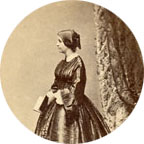 James T. Fields, the Atlantic’s publisher, had an eye for publicity. As the publication date for his magazine approached, he went across the street to the office of the Boston Evening Transcript, the city’s leading newspaper of the day. The idea was to print a piece from the upcoming magazine in the newspaper as a teaser, to entice readers to buy the magazine.
James T. Fields, the Atlantic’s publisher, had an eye for publicity. As the publication date for his magazine approached, he went across the street to the office of the Boston Evening Transcript, the city’s leading newspaper of the day. The idea was to print a piece from the upcoming magazine in the newspaper as a teaser, to entice readers to buy the magazine.And thus it was that “Paul Revere’s Ride” first saw publication on the front page of the Transcript for Tuesday, December 18, 1860. It was in the first column, adjacent to three advertisements for three competing brands of sewing machines. The poem was, in fact, the only item on the front page that wasn’t an advertisement.
At the head of the poem was this note by the Transcript’s editors, in brackets:
[The charming poem which follows is taken from the advanced sheets of the Atlantic Monthly for January. It is from the pen of Mr. Longfellow, who, we are glad to learn, will favor the readers of the Atlantic with frequent contributions.]Two days later, on Thursday, December 20, the January 1861 issue of The Atlantic Monthly was released, with “Paul Revere’s Ride” on pages 27–29. Longfellow’s call to arms was uncannily timely. On that very day, South Carolina seceded from the Union.
With all the tumult of national politics, Longfellow’s verse seems to have gotten little attention. There are no known reviews or comments on it, no known correspondence between Longfellow and his colleagues about it. Only Longfellow’s wife, Fanny (shown above), mentioned the poem in a letter to her brother. “Henry has a poem in the January Atlantic—‘Paul Revere’s Ride,’” she wrote, in a sentence sandwiched between items of family news, following a paragraph about the South Carolina Convention.
Half a year after the poem was published, tragedy struck the Longfellows. On July 9, 1861, the poet’s beloved Fanny was fatally burned in a household accident. Longfellow himself was badly injured trying to save her, and his psyche was wounded even more seriously. It was over a year before he could resume writing.
After recuperation at home, travel to Canada, and a summer at Nahant, Longfellow returned to his life’s work in September of 1862. By the end of that month he had imagined a framework for his next book, ultimately to be called Tales of a Wayside Inn. The plot involved six travelers staying at an inn, the guests and the innkeeper telling tales around the fire. The concept allowed Longfellow to take some already written poems—such as “Paul Revere’s Ride”—and to present them alongside new poems written especially for the volume. In this new setting, “Paul Revere’s Ride” became The Landlord’s Tale, narrated by the innkeeper himself.
The inn chosen was the old Red Horse Tavern, in Sudbury, Massachusetts (now called Longfellow’s Wayside Inn). Some of Longfellow’s friends from Cambridge had been regular summer guests at the tavern during the 1850s. Longfellow began writing new poems for the book in October 1862, and he visited the old inn for inspiration on the last day of that month. In April 1863 the manuscript for the volume was submitted to the printer.
After some debate about the title, and revision of some of the poems, Tales of a Wayside Inn was published on November 25, 1863, in an edition of 15,000 copies. “Paul Revere’s Ride” was finally available in book form. A second, illustrated edition was published in 1866.
Also in 1866 came the poem’s first appearance in a compilation, in a four-volume set of The Poetical Works of Henry Wadsworth Longfellow. With this edition, the poem’s text jelled into its final version. There had been minor variations in the text from one version to another in its early appearances; but after 1866 the same exact text appeared in each authorized edition until after the copyright expired.
This article was composed by Charles Bahne, author of The Complete Guide to Boston’s Freedom Trail, for the bulletin of the Paul Revere House. Copyright © 2010 by Charles Bahne. Click here for Part 4.
Extracts from the Henry Wadsworth Longfellow papers are printed courtesy of Houghton Library, Harvard University. Call numbers: Journal, MS Am 1340 (209); poem manuscript, MS Am 1340 (105); G. W. Greene letter, bMS Am 1340.2 (2379), no. 494.
